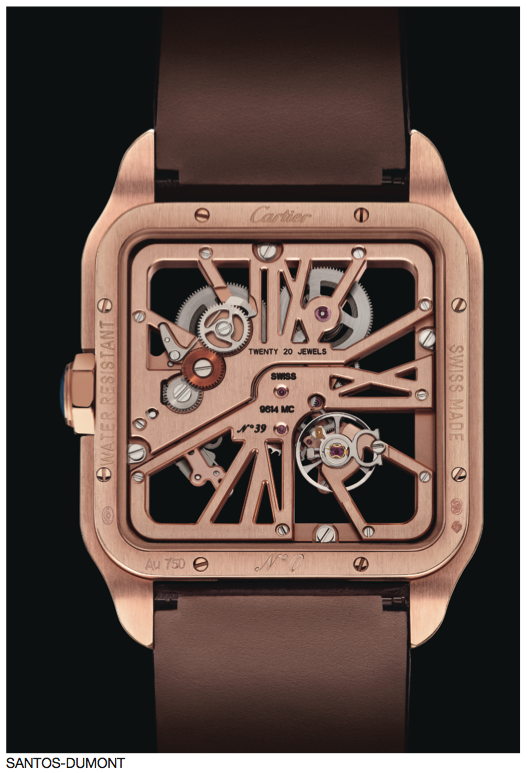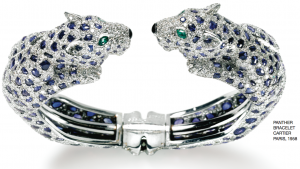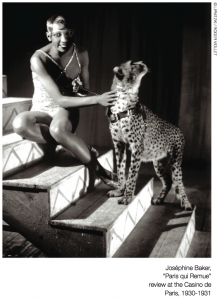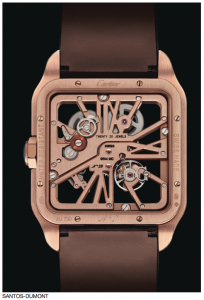Jeweler of Kings, King of Jewelers
Cartier celebrates its heritage in regal fashion by continuing to release new and timeless classics.
By Lois Elfman
In the first 30 years of the 20th century, Cartier obtained no fewer than 15 royal warrants from around the world. “This effectively made Cartier the most well-known luxury jeweler among the royal courts of the world,” says Pierre Rainero, image, style and heritage director of Cartier International.
Beyond the admiration of royals, including Queen Elizabeth II and the late Princess Grace, Cartier inspired jewelry lovers everywhere with chic creations that have become essential items. In 1971, photographer Cecil Beaton captured Elizabeth Taylor wearing her Cartier Love bracelet from Richard Burton to the Rothschilds’ Proust Ball along with elaborate diamond jewelry in her hair and the famous Taylor-Burton diamond around her neck. In 2012, actress Susan Sarandon was seen wearing a Cartier Love bracelet in a recent photo for People magazine. The bracelet is a staple for women who enjoy its elegant simplicity.
Cartier jewelry derives inspiration from many different cultures and influences, and provides inspiration to the world of jewelry design. It has also been an innovator in watches— creating styles that have impacted the entire world.
L’Odyssée de Cartier
On March 4, 2012, Cartier debuted a 3.5-minute film, “L’Odyssée de Cartier,” on the three major U.S. television networks—ABC, NBC and CBS— as well as on YouTube and Facebook. Described as a dialogue between past and present, it is a tribute to the heritage of Cartier. The film’s central character is the panther—both a jeweled version and a live panther—that guides viewers through dreamlike images that depict some of Cartier’s extraordinary creations.
“The film L’Odyssée de Cartier tells the story of the jeweler’s unique history, from its beginnings as a jeweler to European royalty to its modern-day luxury status,” says Emmanuel Perrin, president and CEO of Cartier North America. “It reveals a glimpse into an imaginary world inhabited by Cartier’s designs, under the watchful gaze of its familiar muse, ‘la panthére’ (the panther). The film features many of Cartier’s most enduring and iconic designs, including the Tutti Frutti style, jewelry of the Maharajas and a reference to the Santos watch, which was the first modern watch designed to be worn on the wrist.”
“Strong storytelling,” Michael Coan says of the film. Coan is the chair of the jewelry design department at the Fashion Institute of Technology. “There is a sense of history.
“One point that was made in the video was the incredible grace and strength of this cat,” he adds. “A wild, passionate creature with far-flung travels, experiences and fantasies, yet can come back to be tamed, worn and express love. The video expresses this vividly.”
Perrin says the film weaves together Cartier’s stories in a unique and powerful way through the eyes of the iconic panther. The live panthers used in the filming were shot at studios in Spain, Italy and France as well as at the Grand Palais and Place Vendôme in Paris. Director Bruno Aveillan had a 60-member crew for location shoots in Prague and Paris. An original musical score was created and orchestrated by Pierre Adenot.
“The swirling diamond dust reflects the magical imagination of the house,” Perrin says.
“It was very important for Louis Cartier to innovate, to invent, to go discover other cultures for himself and to use this knowledge to put his own culture into perspective,” Rainero says. “The idea is to create elegant objects for all of life’s moments.”
A Rich Heritage
Cartier was founded in Paris in 1847 by Louis- François Cartier. In 1874, his son Alfred Cartier took over the company. Cartier became a world- renowned company when the founder’s sons, Louis, Pierre and Jacques, assumed leadership. In addition to Paris, there were soon Cartier stores in New York, London and St. Petersburg.
“The Art Deco period (originating in Paris in the 1920s) was to me one of the best periods in jewelry history and especially for Cartier,” says jewelry historian and author Janet Zapata. “They took the art deco style and made some of the best jewelry that’s ever been made. They had the clientele at the time that very much wanted these pieces, and they had the designers.”
Zapata mentions the incredible color palettes that emerged in Cartier jewelry in the 1920s, a time that also saw the first appearance of the Tutti Frutti style. Jacques Cartier had started traveling to India in 1911 and he became fascinated with the engraved gemstones he saw.
“They started to make this very inventive jewelry. Each one is different,” Zapata says. Today, these original pieces are highly sought after at auctions.
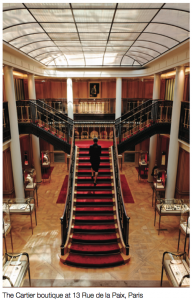 A central person in Cartier’s history is Jeanne Toussaint, who was named artistic director of Cartier fine jewelry in 1933. Under her direction, Cartier began to move away from abstract designs into figurative work, creating some of the iconic pieces that continue to identify Cartier in the 21st century.
A central person in Cartier’s history is Jeanne Toussaint, who was named artistic director of Cartier fine jewelry in 1933. Under her direction, Cartier began to move away from abstract designs into figurative work, creating some of the iconic pieces that continue to identify Cartier in the 21st century.
Nicknamed “the panther,” Toussaint did not create the first panther piece for Cartier, but she did make the best-known pieces starting in 1948, when she created a brooch for the Duchess of Windsor that featured a panther atop an emerald. Cartier notes that the panther remains the historic icon of the house.
“The most iconic Cartier jewel in my opinion has to be the platinum, diamond and onyx panther bracelet made for the Duchess of Windsor in 1952,” says Carol Elkins, senior vice president of the jewelry department at Sotheby’s. “It was included in the sale of her jewels at Sotheby’s Geneva in 1987, and was offered for sale again at Sotheby’s London on Nov. 30, 2010, and fetched a record price of GBP 4,521,250 (approximately $7,250,000).”
Other historically relevant pieces were tiaras, which Coan says were not only for royalty, but were also incredibly popular with debutantes and women in high society in the early part of the 20th century.
“For men, I think the black onyx and colorless diamond cufflinks and shirt studs to be very ‘Cartier’ men’s style,” Coan says. “They displayed a very sleek look for men.”
While renowned for its amazing jewelry, Cartier has equally been an innovator in watches— introducing one of the first wristwatches in history. The Santos, inspired by early aviator Alberto Santos- Dumont, debuted in 1904 based on his need to have greater control while flying. In the film, the panther jumps several times onto an exact replica of Santos- Dumont’s biplane.
Horological expert Osvaldo Patrizzi says the early part of the 20th century was an amazing time for innovation and creativity. The converging influences of art, culture and fashion that came together in Paris, coupled with the superb designers at Cartier, helped bring the Cartier name lasting acclaim.
“If I analyze the quantity and the quality of the beauty of the watches, probably Cartier made the best watches ever from a design point of view,” Patrizzi says. Cartier’s collaboration with Jaeger- LeCoultre, which was renowned for movement design (what makes a watch tick), made Cartier watches extraordinary.
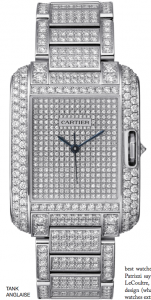 A pivotal moment in watchmaking came about with the launch of the Cartier Tank watch: “If you go back to 1919 when the Cartier Tank was created, it is absolutely the most innovative watch,” Patrizzi says. “It’s flat and easy to wear. The line is a sexy and sensual line. It’s not sharp. It’s nice to touch and beautiful to see.”
A pivotal moment in watchmaking came about with the launch of the Cartier Tank watch: “If you go back to 1919 when the Cartier Tank was created, it is absolutely the most innovative watch,” Patrizzi says. “It’s flat and easy to wear. The line is a sexy and sensual line. It’s not sharp. It’s nice to touch and beautiful to see.”
Patrizzi says Gérard Genta, one of the most influential watch designers of the 20th century, once told him the Tank was one of the best watches he had ever seen and wished he had had a chance to make one because it’s so well proportioned.
Zapata says one thing that appears to be missing from “L’Odyssée de Cartier” were the Mystery Clocks. Introduced in 1912 (later also interpreted as a watch), they were magnificent works of art and timekeeping.
“Essentially, it’s two crystal disks that are put together with hands,” Zapata says. “The gears are in the side of the case. The hands are embedded one in each disk. The gears turn these wheels and it looks like the hands are floating in air.
“In the 1920s, they made some spectacular ones using small Chinese sculptures and antique pieces from the 19th century,” she adds. “Absolutely beautiful.” Art and horology coming together, thanks to Cartier.
Gemological and jewelry expert Kathryn Bonanno says in addition to the iconic panther, Cartier was a leader for many new styles.
“Cartier’s Egyptian revival jewels (early 1920s) were the only ones at the time to be known to contain genuine, antique Egyptian artifacts worked into the unique jewelry masterpieces,” Bonanno says. All of Cartier’s styles—Tutti Frutti, Russian influence, Egyptian and Asian—impacted styles in jewelry around the world, as well as day-to-day items such as cigarette cases and perfume bottles.
“The great designs of Cartier really are timeless, which is perhaps why so many of the past themes are repeated today and the vintage pieces are so sought-after and coveted,” Bonanno continues. “The history together with the avant-garde designs and workmanship are the reasons for so many collectors of vintage Cartier.”
In addition to lavish and elaborate pieces, Cartier has also been an innovator in everyday jewelry. From the whimsical animal brooches begun by Toussaint to the Love bracelet introduced in the 1970s, there are pieces that can be worn day or night. Whatever the choice, Cartier pieces seem to float across a woman’s body.
“For Cartier, it seems always to be a 360-degree proposition—thinking full circle about how a jewel is actually worn and not only considering the wearer but also the visual effect a jewel conveys to the viewer,” Elkins says. “Cartier is superior when it comes to integrating function with design and quality craftsmanship; that is why the feel or ‘hand’ of a Cartier jewel is so soft.”
The year 2012 marks the launches of several lines, including new jewelry pieces as well as contemporary versions of some classic items.
The Tank Anglaise watch collection debuting this June will be available in ladies’ and men’s sizes in three colors of gold. The large models are powered by the Manufacture MC 1904 movement, which is visible through the open back.
Patrizzi says there is such a wealth of beautiful creations that Cartier will be able to make new interpretations for the next 100 years.
The company’s versatility has been a large part of its success, and that continues today. Sensitive to the current tastes for lighter everyday pieces, there are some exquisite new versions of the Juste un Clou, a nail bracelet originally conceived by Aldo Cipullo for Cartier in the 1970s. The newest version will be in yellow, white and pink gold, natural or paved with diamonds.
Cartier will also be debuting its new Fine Watchmaking Collection, which will include the Grand Complication Skeleton pocket watch that has a total of 457 parts, each individually hand-finished. All of the new issues have been painstakingly researched and developed. They are exceptionally lightweight and most will be limited editions.
Also new in 2012 is the High Jewelry Watches collection, which includes the Secret watch with sapphire beads and diamonds, the classic Rivière watch in white gold and diamonds, the Promenade d’une Panthère watch, Calibre 9603 MC, and the Temps Moderne de Cartier watch.
“The basic tenets of Cartier—as of all fine jewelry houses—is on the integrity of their technical expertise, their use of gems, metals and other materials, their commitment to design and to, of course, [give] their clients what they want,” Coan says. “How Cartier reinterprets itself and repositions its designs [are] classic examples of modern times with a twist.”

